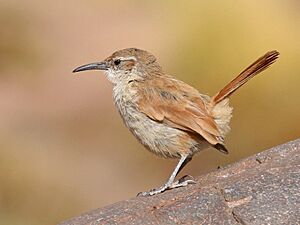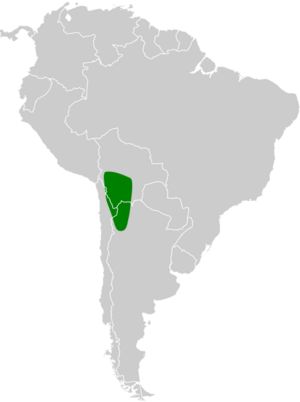Rock earthcreeper facts for kids
Quick facts for kids Rock earthcreeper |
|
|---|---|
 |
|
| Conservation status | |
| Scientific classification | |
| Genus: |
Ochetorhynchus
|
| Species: |
andaecola
|
 |
|
| Synonyms | |
|
|
The rock earthcreeper (Ochetorhynchus andaecola) is a type of bird. It belongs to the ovenbird family called Furnariidae. You can find this bird in Argentina and Bolivia. Sometimes, it might even visit Chile.
Contents
About the Rock Earthcreeper
How Scientists Name Birds
For a while, the rock earthcreeper was placed in a different group of birds called Upucerthia. But since the early 2000s, scientists decided it fits better in its current group, Ochetorhynchus. This bird is also monotypic, which means it's the only species in its specific group.
What Does the Rock Earthcreeper Look Like?
The rock earthcreeper is a medium-sized bird. It is about 16 to 18 centimeters (6 to 7 inches) long. It weighs between 28 and 34 grams (1.0 to 1.2 ounces). Both male and female birds look the same.
This bird has a long beak that curves slightly downwards. It has a light, creamy stripe above its eye. There's also a dark brownish stripe behind its eye. Its cheeks are a light, creamy color.
The top of its head, back, and rump are a rich brown. The feathers under its tail are dark reddish-brown. Its tail is dark reddish, and its wings are a bit more reddish than its back.
Its throat is a creamy white. Its chest and belly are darker, with a yellowish-brown tint. It has darker streaks on its sides. The feathers under its tail are yellowish-brown. Its eyes are brown. Its beak is blackish with a light gray base. Its legs and feet are dark brown or gray-brown. Young birds have pale feather edges on their backs. They also have a scaly pattern on their undersides.
Where the Rock Earthcreeper Lives
Where to Find This Bird
The rock earthcreeper lives in the eastern foothills of the Andes Mountains. You can find it from the La Paz Department in western Bolivia. Its range goes south into northern Argentina, reaching as far as Catamarca Province. It also lives in the very eastern part of the Antofagasta Region of Chile. However, bird experts in South America consider it a rare visitor to Chile.
What Kind of Home Does It Like?
This bird likes dry areas with scrublands and puna grasslands. These areas have tough grasses and scattered bushes. It especially likes rocky hillsides, rocky areas that stick out, and deep valleys. You can usually find it at high elevations. It lives mostly between 2,600 and 4,200 meters (8,500 and 13,800 feet) above sea level. Sometimes, it can be found as high as 4,500 meters (14,800 feet).
Rock Earthcreeper Behavior
How It Moves Around
The rock earthcreeper usually stays in the same area all year long. It does not migrate, except perhaps for the birds that visit Chile.
What It Eats and How It Finds Food
The rock earthcreeper looks for its food on the ground. It mainly eats arthropods, which are creatures like insects and spiders. It usually hunts alone, but sometimes in pairs. It picks up and pulls out its prey while hopping among rocks, grasses, and bushes. This bird can be shy and hard to get close to. If it feels disturbed, it will fly away a long distance.
Reproduction and Life Cycle
Scientists believe that the rock earthcreeper stays with one partner for breeding. It seems to breed during the southern summer. This bird digs a tunnel in an earthen bank to make its nest. It might also use a crack in a rock. It lines the nest with soft materials like grass, hair, and feathers. The female usually lays two eggs. We don't know how long the eggs take to hatch. We also don't know how long it takes for the young birds to leave the nest. Details about how the parents care for their young are also unknown.
What Sounds Does It Make?
The rock earthcreeper sings from a high spot, like a bush or a large rock. Its song is a series of loud, sharp notes that sound like "vee-vee-vee-vee-vi-veet." Sometimes, the song ends with a sputtering sound. It also has an alarm call. This call is a high-pitched, squeaky whistle that sounds like "zuwééét." It's similar to a sound a small rodent might make.
Conservation Status
The IUCN (International Union for Conservation of Nature) has evaluated the rock earthcreeper. They have listed it as a species of "Least Concern." This means it is not currently in danger of disappearing. It lives in a somewhat limited area. Its total population size is not known, and it is thought to be decreasing. However, no immediate threats have been found. It is considered uncommon to fairly common. Experts believe it is "reasonably secure." The only human activity that might affect it is too much grazing by animals.


